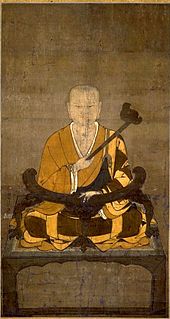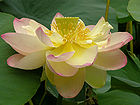- Zhiyi
-
Lands India • China • Japan
Vietnam • Korea
Singapore • Taiwan
Tibet • Bhutan • Nepal
Mongolia • United StatesDoctrine Bodhisattva • Śīla
Samādhi • Prajñā
Śunyatā • TrikāyaMahāyāna Sūtras Prajñāpāramitā Sūtras
Lotus Sūtra
Nirvāṇa Sūtra
Saṃdhinirmocana Sūtra
Avataṃsaka Sūtra
Śūraṅgama SūtraMahāyāna Schools Mādhyamaka
Yogācāra
Esoteric Buddhism
Pure Land • Zen
Tiantai • NichirenZhiyi (Chinese: 智顗; pinyin: zhì yǐ; Wade–Giles: Chih-I; Japanese: Chigi) (538–597 CE) is traditionally listed as the fourth patriarch, but is generally considered the founder of the Tiantai tradition of Buddhism in China. His standard title was Śramaṇa Zhiyi (Ch. 沙門智顗), linking him to the broad tradition of Indian asceticism. Zhiyi is famous for being the first in the history of Chinese Buddhism to elaborate a complete, critical and systematic classification of the Buddhist teachings. He is also regarded as the first major figure to make a significant break from the Indian tradition, to form an indigenous Chinese system.
Contents
Biography
Born with the surname Chen (陳) in Huarong District, Jing Prefecture (荊州華容), Zhiyi left home to become a monk at eighteen, after the loss of his parents and his hometown Jiangling that fell to the Western Wei army when Zhiyi was seventeen. At 23, he received his most important influences from his first teacher, Nanyue Huisi (慧思) (515-577 CE), a meditation master who would later be listed as Zhiyi's predecessor in the Tiantai lineage. After a period of study with Huisi, he spent some time working in the southern capital of Jinling (金陵). Then in 575 he went to Tiantai mountain for intensive study and practice with a group of disciples. Here he worked on adapting the Indian meditation principles of śamatha and vipaśyanā (translated as "zhi" and "guan") into a complex system of self-cultivation practice that also incorporated devotional rituals and confession/repentance rites. Then in 585 he returned to Jinling, where he completed his monumental commentarial works on the Lotus Sutra, the Fahua wenzhu (587 CE), and the Fahua xuanyi (593 CE).
Chappell (1987: p. 247) holds that Zhiyi: "...provided a religious framework which seemed suited to adapt to other cultures, to evolve new practices, and to universalize Buddhism."[1]
Zhiyi and Bodhidharma were contemporaneous,[2] though Zhiyi had royal patronage whilst Bodhidharma did not.
Important works
Rujun Wu (1993: p. 1) identifies the Mohe Zhiguan of Zhiyi as the seminal text of the Tiantai school.[3]
Among Zhiyi's many important works are the Mohe Zhiguan, Liumiao Famen, Fahua Wenzhu, and Fahua Xuanyi. Of the works attributed to him (although many may have been written by his disciples), about thirty are extant.
Four Samadhis
Chih-i developed a curriculum of practice which was distilled into the 'Four Samadhis' (Chinese: 四種三昧;[4] Wade-Giles: ?).[5] These Four Samadhi were expounded in Zhiyi's 'Mohe Zhiguan' (Chinese: 摩訶止観, Jpn.: Makashikan).[6] The Mohe Zhiguan is the magnum opus of Zhiyi's maturity and is held to be a "grand summary" (p. 2) of the Buddhist Tradition according to his experience and understanding at that time.[2] The text of the Mohe Zhiguan was refined from lectures Zhiyi gave in 594 in the capital city of Chin-ling and was the sum of his experience at Mount T’ien-t’ai c.585 and inquiry thus far.[7] Parsing the title, 'zhi' refers to "ch’an meditation and the concentrated and quiescent state attained thereby" (p. 4) and 'guan' refers to "contemplation and the wisdom attained thereby" (p. 4).[8] Swanson (2002: p. 4) reports that Chih-i held that there are two modes of 'chih-kuan': that of sitting in meditation 坐, and that of “responding to objects in accordance with conditions” 歴縁対境, which is further refined as abiding in the natural state of a calm and insightful mind under any and all activities and conditions.[8]
Swanson (2002: p. 1) states that Zhiyi in the Mohe Zhiguan:
...is critical of an unbalanced emphasis on “meditation alone,” portraying it as a possible “extreme” view and practice, and offering instead the binome chih-kuan 止観 (calming/cessation and insight/contemplation, śamatha-vipaśyanā) as a more comprehensive term for Buddhist practice.[9]
The "Samadhi of One Practice" (Skt. Ekavyūha Samādhi; Ch. 一行三昧) which is also known as the "samadhi of oneness" or the "calmness in which one realizes that all dharmas are the same" (Wing-tsit Chan), is one of the Four Samadhi that both refine, mark the passage to, and qualify the state of perfect enlightenment expounded in the Mohe Zhiguan.[6] The term "Samadhi of Oneness" was subsequently used by Daoxin.[10]
The Four Samadhis:
- 'Samadhi of Constant Sitting' (Chinese: 常坐三昧) or 'One Round Samadhi' (Chinese: 一行三昧);
- 'Pratyutpanna-samadhi' (Chinese: 般舟三昧) or 'Prolonged Samadhi' or 'Samadhi of Constant Walking' (Chinese: 常行三昧);
- 'Samadhi of Half Walking and Half Sitting' (Chinese: 半行半坐三昧)
- 'Samadhi at Free Will' (Chinese: 隨自意三昧) or 'Samadhi of Non-walking and Non-sitting' (Chinese: 非行非坐三昧)
Notes
- ^ Chappell, David W. (1987). 'Is Tendai Buddhism Relevant to the Modern World?' in Japanese Journal of Religious Studies 1987 14/2-3. Source: [1]; accessed: Saturday August 16, 2008. p.247
- ^ a b Swanson, Paul L. (2002). Ch'an and Chih-kuan: T'ien-t’ai Chih-i's View of “Zen” and the Practice of the Lotus Sutra. Presented at the International Lotus Sutra Conference on the theme “The Lotus Sutra and Zen”, 11–16 July 2002. Source: [2] (accessed: August 6, 2008). p.2
- ^ Rujun Wu (1993). T'ien-T'ai Buddhism and early Mādhyamika. National Foreign Language Center Technical Reports. Buddhist studies program. University of Hawaii Press. ISBN 0824815610, 9780824815615. Source: [3] (accessed: Thursday April 22, 2010)
- ^ Swanson, Paul L. (2002). Ch'an and Chih-kuan: T'ien-t’ai Chih-i's View of “Zen” and the Practice of the Lotus Sutra. Presented at the International Lotus Sutra Conference on the theme “The Lotus Sutra and Zen”, 11–16 July 2002. Source: [4] (accessed: August 6, 2008). p.5
- ^ Chappell, David W. (1987). 'Is Tendai Buddhism Relevant to the Modern World?' in Japanese Journal of Religious Studies 1987 14/2-3. Source: [5]; accessed: Saturday August 16, 2008. p.249
- ^ a b Dumoulin, Heinrich (author); Heisig, James W. (trans.) & Knitter, Paul (trans.)(2005). Zen Buddhism: A History. Volume 1: India and China. World Wisdom. ISBN 978-0-941532-89-1. p.311
- ^ Swanson, Paul L. (2002). Ch'an and Chih-kuan: T'ien-t’ai Chih-i's View of “Zen” and the Practice of the Lotus Sutra. Presented at the International Lotus Sutra Conference on the theme “The Lotus Sutra and Zen”, 11–16 July 2002. Source: [6] (accessed: August 6, 2008). p.5
- ^ a b Swanson, Paul L. (2002). Ch'an and Chih-kuan: T'ien-t’ai Chih-i's View of “Zen” and the Practice of the Lotus Sutra. Presented at the International Lotus Sutra Conference on the theme “The Lotus Sutra and Zen”, 11–16 July 2002. Source: [7] (accessed: August 6, 2008). p.4
- ^ Swanson, Paul L. (2002). Ch'an and Chih-kuan: T'ien-t’ai Chih-i's View of “Zen” and the Practice of the Lotus Sutra. Presented at the International Lotus Sutra Conference on the theme “The Lotus Sutra and Zen”, 11–16 July 2002. Source: [8] (accessed: August 6, 2008). p.1
- ^ Sheng-Yen, Master (聖嚴法師)(1988). Tso-Ch'an. Source: [9]; (accessed: August 6, 2008) p.364
See also
References
Print
- Dumoulin, Heinrich (author); Heisig, James W. (trans.) & Knitter, Paul (trans.)(2005). Zen Buddhism: A History. Volume 1: India and China. World Wisdom. ISBN 978-0-941532-89-1
- Donner, Neal & Daniel B. Stevenson (1993). The Great Calming and Contemplation. Honolulu: University of Hawai‘i Press.
- Hurvitz, Leon (1962). Chih-i (538-597): An Introduction to the Life and Ideas of a Chinese Buddhist Monk. Mélanges Chinois et Couddhiques XII, Bruxelles: Institut Belge des Hautes Études Chinoises.
Electronic
- Chappell, David W. (1987). 'Is Tendai Buddhism Relevant to the Modern World?' in Japanese Journal of Religious Studies 1987 14/2-3. Source: [10]; accessed: Saturday August 16, 2008
- Dumoulin, Heinrich (1993). "Early Chinese Zen Reexamined ~ A Supplement to 'Zen Buddhism: A History'" in Japanese Journal of Religious Studies 1993 20/1. Source: [11] (accessed: August 6, 2008)
- Swanson, Paul L. (2002). Ch'an and Chih-kuan: T'ien-t’ai Chih-i's View of “Zen” and the Practice of the Lotus Sutra. Presented at the International Lotus Sutra Conference on the theme “The Lotus Sutra and Zen”, 11–16 July 2002. Source: [12] (accessed: August 6, 2008)
- Sheng-Yen, Master (聖嚴法師)(1988). Tso-Ch'an. Source: [13]; (accessed: August 6, 2008)
External links
- Digital Dictionary of Buddhism (log in with userID "guest")
- Biography in Chinese
- Buddhism of T'ien-T'ai
Categories:- 538 births
- 597 deaths
- Buddhist philosophers
- Northern Wei Buddhists
- Northern Zhou Buddhists
- Sui Dynasty Buddhists
- Tiantai Buddhists
- People from Ezhou
Wikimedia Foundation. 2010.


